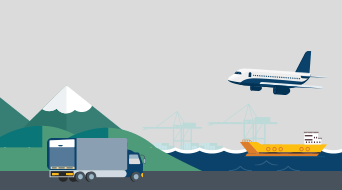Freight Shipping Insights: Modes of Transportation
Despite uncertainty caused by the ongoing COVID-19 pandemic, e-commerce sales have remained steady in 2020 and, in some cases, even surpassed 2019 rates. In fact, during the second quarter of 2020 (April through June), American consumers spent $1 of every $5 online — a 44% increase from 2019.
This dramatic increase in online orders has put an unprecedented amount of packages in route, keeping the freight shipping industry moving despite the GDP fall earlier this year. And as online orders continue to flow in, small and mid-sized businesses (SMBs) should understand the outlook of various freight transportation methods — and which are most efficient for the unique and changing needs of your business.
What’s the outlook on common freight shipping modes?
Ground shipping
As one of the oldest and most common forms of freight shipping, ground transportation is a reliable and time-proven shipping method. And with the growth in online sales, the truck to facility route continues to be well utilized. In fact, freight spending reportedly fell less than the national GDP. As of late July, truckload volumes were up 27% from last year, which is especially promising due to the GDP fall in Q2.
Industry experts predict that ground shipping volumes will continue to hold steady throughout the year, however, we’ll have to wait and see how the back-to-school season — which accounts for more than 7% of consumer spending in Q3 — impacts volume levels going into Q4. No matter the direction of future volume trends, you can count on your Unishippers team to get your freight on the road in times of limited capacity.
Air freight
The real opportunity for projected freight shipping growth seems to be in air transportation. Though air freight has been impacted by decreased global trade, it is starting to rise in demand yet again as businesses try to deliver shipments faster — even if it costs more. While the year-over-year growth rate for air freight in 2020 is estimated at 3.1%, it’s predicted that market growth will accelerate by 4% between 2020 and 2024.
As the fastest growing form of transport — and with the current rise of e-commerce shipments — it may be time to prioritize air freight as an especially time-effective shipping option. Through our valuable partnership with UPS®, we provide SMBs access to a wide array of international and domestic air freight options at competitive rates with UPS Air Freight.
Ocean freight
As one of the most cost effective ways to ship large cargo across the globe, ocean freight plays a critical role in worldwide trade. However, due in part to the COVID-19 pandemic, ocean freight shipping volumes have been low — and are forecasted to remain low for much of the year.
One of the main causes of low ocean freight volumes are “blank sailings,” meaning that a once scheduled freight sailing has been canceled. These cancellations are expected to continue through at least September, if not more of the year. To counteract GDP falls and overall revenue difficulties, ocean freight carriers are tightening their capacity to keep operating costs low. So if you plan to ship ocean freight in 2020, make sure to book a few weeks in advance to avoid delays.
Wondering if ocean freight is right for your business? Learn more about this and other freight service types with our guide.
Let a 3PL help get your freight on the road
Working with a third-party logistics (3PL) provider with access to competitive rates and a large carrier portfolio can help minimize the impact of tight freight shipping capacity throughout the rest of the year and beyond. Contact Unishippers today to learn how we can help get your freight on the road — whether by ground, air or sea.
Last Updated 9/23/2020


